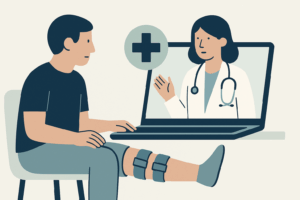Table of Contents
- Telerehabilitation: Revolutionizing Post-Surgical Recovery
- The Limitations of Traditional Physical Therapy
- Technology-Driven Solutions for Patient Empowerment
- Evidence-Based Outcomes That Matter
- The Dr Telx Perspective on Modern Rehabilitation
- Integrating Telerehabilitation into Comprehensive Care
- Overcoming Implementation Challenges
- Conclusion: Embracing the Future of Rehabilitation
Telerehabilitation: Revolutionizing Post-Surgical Recovery
A recent article from Healthcare IT News highlights how Hospital for Special Surgery (HSS) Florida has transformed post-knee replacement recovery through telerehabilitation technology. The report details how implementing ROMTech’s PortableConnect system led to significantly improved patient outcomes, reduced pain, better range of motion, and decreased healthcare costs by an average of $2,460 per patient. You can read the full article here.
This case study presents compelling evidence for the effectiveness of telerehabilitation in addressing longstanding challenges in post-surgical care. The traditional approach—limited home visits from therapists and paper exercise instructions—often leaves patients without sufficient guidance and support during critical recovery periods.

The Limitations of Traditional Physical Therapy
The traditional rehabilitation model after knee replacement surgery has significant shortcomings that can hinder optimal recovery. Geographic limitations, scheduling difficulties, and infrequent therapy sessions (typically just 2-3 times weekly) create gaps in care that can compromise outcomes.
Many patients struggle with self-directed exercises on days without therapist supervision. This results in inconsistent practice, improper technique, and ultimately, suboptimal recovery trajectories. The anxiety and tension described in post-operative visits are all too familiar to healthcare providers.
As telehealth practitioners at Dr Telx, we recognize that these challenges are not unique to orthopedic surgery. Similar gaps exist across numerous medical specialties where consistent, guided rehabilitation is essential for optimal outcomes.
Technology-Driven Solutions for Patient Empowerment
The HSS Florida case demonstrates how telerehabilitation technology addresses these fundamental problems. By providing patients with both the tools and guidance needed for consistent, frequent therapy sessions, recovery becomes more patient-centered and effective.
What stands out is how the technology transforms patients from passive recipients of care to active participants in their recovery. The article notes that patients feel “empowered” when using telerehabilitation—a sentiment that aligns perfectly with our philosophy at Dr Telx.
Digital health solutions that provide real-time feedback create positive reinforcement loops. When patients can visually track improvements in range of motion or strength, motivation increases naturally, leading to better adherence and outcomes.

Evidence-Based Outcomes That Matter
The study’s findings are particularly compelling because they measure outcomes that genuinely matter to patients: pain reduction, improved mobility, and enhanced quality of life. The improvements were not just statistically significant but exceeded the minimum clinically important difference (MCID)—meaning patients actually felt these improvements in their daily lives.
Equally important is the cost analysis showing substantial savings per patient. In an era of value-based care, interventions that improve outcomes while reducing costs represent the gold standard for healthcare innovation.
These results challenge the false assumption that telehealth options are merely convenience-focused alternatives. Instead, they demonstrate that properly designed telehealth interventions can outperform traditional approaches in both clinical outcomes and economic efficiency.
The Dr Telx Perspective on Modern Rehabilitation
At Dr Telx, we view telerehabilitation as a critical component of comprehensive patient care. Our experience shows that when patients receive consistent guidance, appropriate tools, and regular feedback, they recover faster and more completely from a wide range of conditions.
The HSS Florida case reinforces our observation that telehealth solutions work best when they combine technology with human expertise. The device itself is valuable, but its integration into a care plan designed by skilled professionals maximizes its impact.
We believe this approach represents the future of rehabilitation—one where technology extends the reach and effectiveness of healthcare professionals rather than replacing them. This synergy creates more touchpoints for patients while reducing the burden on healthcare systems.
Integrating Telerehabilitation into Comprehensive Care
While the featured study focuses on knee replacement recovery, the principles apply broadly across many conditions requiring ongoing rehabilitation. From cardiac recovery to neurological rehabilitation to chronic pain management, similar approaches could transform outcomes.
Dr Telx’s telewellness model focuses on creating personalized care plans that leverage technology to maintain continuous connections with patients. This approach eliminates the “care deserts” that occur between traditional in-person visits.
By incorporating telerehabilitation tools into comprehensive care plans, we can address both physical recovery and the psychological aspects of healing. The confidence patients gain from consistent guidance reduces anxiety and improves overall wellbeing.

Overcoming Implementation Challenges
The article mentions that integrating telerehabilitation into existing workflows initially concerned the HSS Florida team. However, they found the process surprisingly efficient, ultimately saving time through reduced patient calls and concerns.
This reflects our experience at Dr Telx, where initial investment in telehealth processes yields substantial downstream efficiencies. Proactive care through telehealth prevents complications that would otherwise require resource-intensive interventions.
For healthcare organizations considering similar implementations, we recommend starting with well-defined patient populations where outcomes can be clearly measured. Success in initial applications builds institutional confidence for broader implementation.
Conclusion: Embracing the Future of Rehabilitation
The HSS Florida case study presents compelling evidence that telerehabilitation technology can significantly improve patient outcomes while reducing healthcare costs. This approach transforms the rehabilitation experience by empowering patients, providing consistent guidance, and enabling real-time progress tracking.
At Dr Telx, we strongly endorse the integration of telerehabilitation tools into comprehensive care plans. These technologies extend the reach of healthcare professionals, improve patient engagement, and bridge the gaps in traditional care models.
The future of healthcare will increasingly depend on our ability to leverage technology that keeps patients connected to their care teams between traditional visits. By embracing these innovations, we can create more effective, efficient, and patient-centered approaches to healing and wellness.
Want to see how telerehabilitation can transform outcomes for your patients? At Dr Telx, we’re already helping providers implement these cutting-edge solutions to deliver more consistent, cost-effective, and patient-driven care. Book a demo today and discover how our telewellness platform can elevate your rehabilitation services and support recovery that’s smarter, faster, and more connected.

